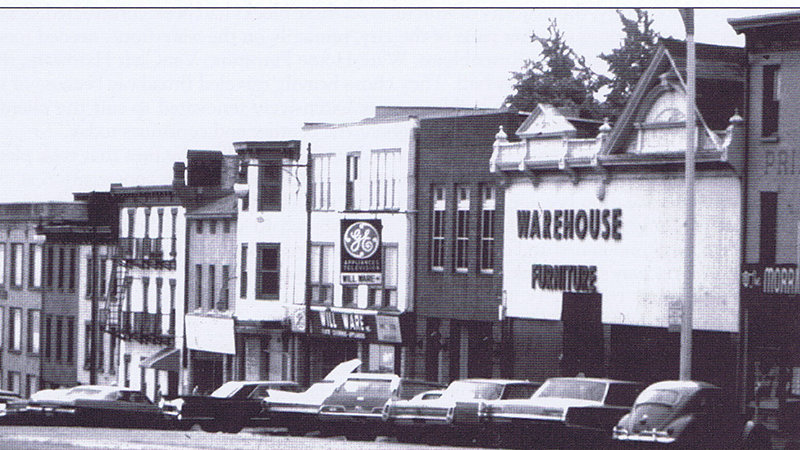
Ware House Furniture Annex in the late 1960’s.
By Mary McTamaney
Out of a dusty closet, wonderful things can sometimes emerge.
Recently, someone gave the Newburgh Historical Society a scrapbook that seems to have belonged to the Spier family. A few of the faces among the old photographs can be identified and some family members were even photographed at various stages of their lives.
Spier is a family name that goes back to the earliest days of the Village of Newburgh. Hugh Spier was on the first village board when it formed in 1800. He was the community’s first cabinetmaker and its first undertaker. Those occupations often were practiced together since the carpenter with furniture skills could easily make caskets too. In the late 18th century, Hugh Spier advertised in the Newburgh Packet newspaper as doing business at the corner of Smith and Second Streets, “at the sign of the cradle and coffin.”
History books confirm that Hugh was one of the original trustees of the Associate Reformed Church and of the Newburgh Academy. He also appears in the early records of Newburgh’s volunteer fire company formed in 1797.
The Spier family grew and prospered in Newburgh. By 1849, Hugh’s son Thomas operated a foundry on Western Avenue opposite High Street where he specialized in light castings, particularly stoves and plows. Those items alone, in such constant demand, would have kept customers coming to his door.
The old scrapbook just yielded a picture of that very door – the front of Spier and Wilson’s Foundry on Western Avenue. Its location was just opposite High Street next to the old firehouse known as Washington Steamer. The address, once street numbers were assigned, was 65-67 Western Avenue. (In 1880, Newburgh rebranded its wide main street as Broadway).
It is remarkable how long the building Thomas Spier built for his casting shop, probably before the Civil War, lasted into the 20th century. It transitioned to a stable for the many horses that needed to be watered, fed and sheltered during their work of pulling wagons to and from Newburgh.
Then, when the horseless carriage emerged at the beginning of the twentieth century, Leroy Cowley opened a full-service garage to provide gas, oil and parts for automobiles and trucks. Mr. Cowley called his place The Blue Front Motor Mart after he added nice decorative trim to the facade of the old Spier foundry and painted it a bright blue. Out at the curb, gasoline was dispensed from a rolling tank. It looks like customers would have to make many visits since that tank is quite small by modern standards.
The last phase of Thomas Spier’s foundry was its life as an annex for Ware House Furniture, a store that also saw over two generations of Newburgh commerce. Ware House moved “uptown” to the city line and into the old Big Scot Department Store after urban renewal destroyed its two locations at Broadway and Colden Street and this annex diagonally up the block at 65-67 Broadway.
By the late 1960’s it was hard to envision the old Spier and Wilson Foundry or the old Washington Steamer Firehouse next door after modern facades had been applied.
No notes were written on the back of the faded photograph so we can’t be sure if Thomas Spier is one of the men posing out on Western Avenue or if his brief partner, Mr. Wilson, is the other character. History books do confirm that when the Erie Railroad was being planned to come to Newburgh in 1849, Spier and Wilson pledged a generous sum of $500 in stock purchases. So there must have been some profit in casting iron.